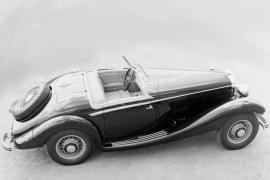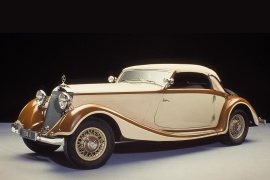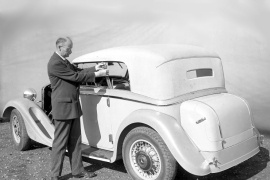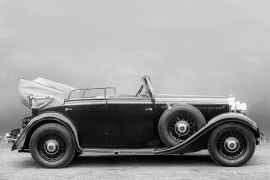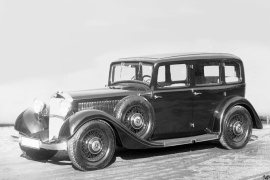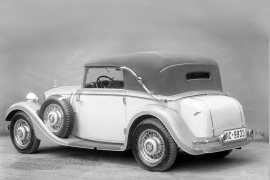MERCEDES BENZ Typ 290 Models/Series Timeline, Specifications & Photos
First production year: 1933
Engines: Gasoline
Mercedes-Benz introduced the Type 290 Roadster in early 1936 as a sport version for the range, a vehicle that received all the updates developed for the rest of the range.
The German carmaker was almost done developing a new model, the Type 320, but it still didn't have any sports roadster. Sure, it had a few convertible versions, but not a roadster. It needed something to compete against another German carmaker located in Bavaria, BMW.
In 1935, Mercedes-Benz introduced new updates for the Type 290. In addition to increased power, it offered the car a choice of two wheelbases. For the Sport Roadster, it chose the short wheelbase version, which was lighter. The car featured a tilted, pinned-out radiator at the front, behind the chromed bumper, but in front of the front axle. Its engine compartment was flanked by the long and arched wheel fenders continued by the side steps. Like its sibling, the 1935 Cabriolet A, it featured two tumble-seats behind the cabin, in front of the spare wheels mounted in the back on the sloped side of the trunk.
Mercedes installed rear-hinged doors to access the luxurious yet sporty cabin. It provided comfort for two passengers in a leather-clad interior. The dash panel featured a center-mounted instrument panel.
Under the hood, the carmaker used the upgraded version of the 2.9-liter engine. Its 68 hp could propel the car to speeds above 100 kph (62 mph), and it could keep pace with its newest competitor, the BMW 327 convertible.
When Mercedes-Benz introduced the new lineup, named Typ 290, at the 1933 Berlin Motor Show, the economic crisis was already gone, and Germany's economy was rising again.
That made the German automaker more creative and produced several closed or open-top vehicles on the same W18 chassis, available in two wheelbases. One of them was the Cabriolet A, which was a two-seat convertible fitted with the same engine and gearbox that moved the heavier Typ 290 Sedan. Moreover, thanks to its independent suspension in all corners, it provided more comfort than most other carmakers could provide.
With its sporty look, the Cabriolet A was considered a personal luxury convertible. Its long engine compartment that hosted the inline-six powerplant was flanked by the valanced front fenders extended continued with the side steps to ease the occupants' ingress and egress. At the front, the V-shaped grille was surrounded by a thick chromed rim, while the arched bar in front of it supported the three headlights. To access the cabin, Mercedes installed rear-hinged doors, which were considered more practical, even though they were not that safe. At the back, the sloped trunk created a flowing line and evoked sportiness. For long travels, the carmaker prepared a cradle for two spare wheels mounted behind the trunk between the half rear bumpers.
Inside, the cockpit featured two leather-wrapped bucket seats. The four-on-the-floor shifter was bent so the driver could use it properly without hitting the passenger's knees. On the dash panel, the automaker installed three dials, with the gauges for the fuel level and coolant temperature on the left, the speedometer in the middle, and the tachometer on the right.
The 2.9-liter engine offered 59 hp (60 PS) at the launch. Later, the automaker increased the compression ratio and gained eight more ponies.
In 1933, Mercedes-Benz introduced the 290 W18 series at the International Motor and Motorcycle Show in Berlin as a new range that consisted of sedans, open-top, and cabriolets.
With a refreshed lineup and a new platform, Mercedes-Benz proved once again that improvements in all areas drove it. The new W18 was available with two wheelbases and offered convertible bodies for both.
The Cabriolet B was based on the long-wheelbase solution and was offered as a Gran Tourer, retractable top vehicle. At the front, a chromed bar mounted between the front fenders supported the two big headlights and, behind them, the radiator stood flat and tall, creating a commanding view. With its sloped-down beltline toward the end of the car, it created an overall dynamic look. In the back, the trunk was half integrated into the car's body, and it was accessible only from the outside.
Its luxurious cabin offered room for up to five passengers, including the driver, on leather seats. For the front occupants, the two individual seats offered a comfortable ride. Mercedes-Benz used wood for the dashboard and a black area for the instrument panel.
Mercedes-Benz installed a swing axle in the rear, with two coil springs on each side, allowing each wheel to have an independent travel behavior. Two parallel wishbones controlled the front wheels, with a coil spring between the upper and lower arms. All this setup allowed a comfortable ride over bumpy roads. Under the hood, the carmaker installed a 2.9-liter engine, which was an evolution over the 2.6-liter one from the Stuttgart 260. The 1934 Cabriolet B offered 60 hp, but the engineers upgraded the engine to 68 hp from 1935. It was paired to a manual gearbox with direct-drive in third gear and a vacuum-selectable overdrive.
Mercedes-Benz introduced the 290 range in 1933 at the Berlin International Motor and Motorcycle Show as a sedan and three convertibles.
The German carmaker built a chassis with a choice of two wheelbases, short and long. While Cabriolet A and C were based on the former, the B and D were built on the later version. Due to the big canvas, the engineers had to install a removable B-pillar.
At the front, the car sported a chromed bar mounted between the front fenders supported the two big headlights, and, behind them, the radiator stood flat and tall, creating a commanding view. With its sloped-down beltline toward the end of the car, it made an overall dynamic look. Mercedes-Benz offered the Cabriolet D as a long-travel vehicle, with a luggage rack behind the bodywork, in front of the rear bumper.
Its luxurious cabin offered room for up to five passengers, including the driver, on leather seats. For the front occupants, the two individual seats provided a comfortable ride. The removable B-pillars could have been installed when the canvas top was up. Due to the car's rear doors' shapes, the rear passengers couldn't completely wind down the back windows.
Mercedes-Benz installed a swing axle in the rear, with two coil springs on each side, allowing each wheel to have an independent travel behavior. Two parallel wishbones controlled the front wheels, with a coil spring between the upper and lower arms. All this setup allowed a comfortable ride over bumpy roads. Under the hood, the carmaker installed a 2.9-liter engine, which was an evolution over the 2.6-liter one from the Stuttgart 260. The 1934 Cabriolet D offered 60 hp, but the engineers upgraded the powerplant to 68 hp from 1935.
Mercedes-Benz was quick back on its feet after the Great Depression that affected the world Economy in the early 30s and introduced the Typ 290 (W18) lineup at the International Motor and Motorcycle Show in Berlin as a new range that consisted of sedans, open-top, and cabriolets.
Thanks to the new platform, the German carmaker managed to overtake its competitors, which relied on older chassis. In addition, the Typ 290 was available with two wheelbases. One of the most important models from the lineup was, obviously, the sedan.
Based on the long-wheelbase version, the car offered a four-door solution fitted with large windows all around. Moreover, the carmaker offered the vehicle an option for a removable top, so passengers could enjoy a breath of fresh air, even though it was not a true cabriolet. At the front, the car featured an arched chromed bar mounted between the front fenders. It supported the two big headlights, and behind them, the radiator stood flat and tall, creating a commanding view. The curved front fenders hosted the spare wheels and were extended onto the side steps toward the rear quarter panels.
Its luxurious cabin offered room for up to five passengers, including the driver, on leather seats. For the front occupants, the two individual seats offered a comfortable ride. Mercedes-Benz used wood for the dashboard and a black area for the instrument panel.
Mercedes-Benz installed a swing axle in the rear, with two coil springs on each side, allowing each wheel to have an independent travel behavior. Two parallel wishbones controlled the front wheels, with a coil spring between the upper and lower arms. All this setup allowed a comfortable ride over bumpy roads. Under the hood, the carmaker installed a 2.9-liter engine, which was an evolution over the 2.6-liter one from the Stuttgart 260. It was paired to a manual gearbox with a direct drive in the third gear and a vacuum-selectable overdrive.
When Mercedes-Benz introduced the 290 W18 Series at the 1933 Berlin International Motor and Motorcycles Show, it offered the car in many shapes, including a choice of three cabriolets.
While other carmakers could barely offer one convertible on the market, the German carmaker had more convertibles for one series. The Typ 290 Cabriolet was available with a long or a short wheelbase, with a luxurious package or a standard trim level. But, above all, it was a Mercedes-Benz, a car that was already notorious for its qualities.
Available since 1933, the long-wheelbase W18 Cabriolet C featured a chromed bar mounted between the front fenders supported the two big headlights and, behind them, the flat and tall radiator. With its sloped-down beltline toward the end of the car, it created an overall dynamic look. The folding roof sported two chromed swing arms on the sides. In the back, the trunk was half integrated into the car's body, and it was accessible only from the outside.
Mercedes-Benz installed a luxurious cabin fit for up to five occupants. There were two wide seats at the front, while in the back, the carmaker installed a bench for three. The dash panel featured wood veneers and a black panel for the instrument cluster.
Mercedes-Benz installed a swing axle in the rear, with two coil springs on each side, allowing each wheel to have an independent travel behavior. Two parallel wishbones controlled the front wheels, with a coil spring between the upper and lower arms. All this setup allowed a comfortable ride over bumpy roads. Under the hood, the carmaker installed a 2.9-liter engine which offered 60 hp from 1933. In the following year, the carmaker increased the compression ratio and gained another eight hp.
